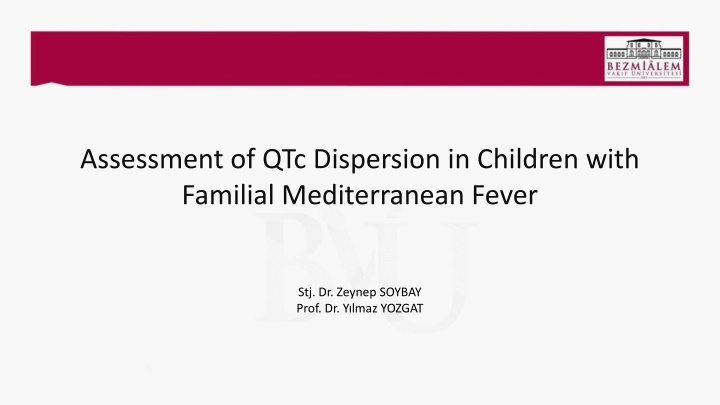
QTc Dispersion Assessment in Children with Familial Mediterranean Fever
Learn about the assessment of QTc dispersion in children with Familial Mediterranean Fever, an autoinflammatory disease, and how it relates to cardiovascular risks. The study involves 45 patients diagnosed with FMF and healthy volunteers as the control group, exploring heart rate, P wave characteristics, QT interval, and more.
Download Presentation

Please find below an Image/Link to download the presentation.
The content on the website is provided AS IS for your information and personal use only. It may not be sold, licensed, or shared on other websites without obtaining consent from the author. If you encounter any issues during the download, it is possible that the publisher has removed the file from their server.
You are allowed to download the files provided on this website for personal or commercial use, subject to the condition that they are used lawfully. All files are the property of their respective owners.
The content on the website is provided AS IS for your information and personal use only. It may not be sold, licensed, or shared on other websites without obtaining consent from the author.
E N D
Presentation Transcript
Assessment of QTc Dispersion in Children with Familial Mediterranean Fever Stj. Dr. Zeynep SOYBAY Prof. Dr. Y lmaz YOZGAT
Familial Mediterranean Fever (FMF) is the most common hereditary autoinflammatory disease in the world, manifested by inflammatory attacks such as self-limiting fever, pleuritis, peritonitis, arthritis and serositis. General prevalence of FMF in Turkey has been reported as approximately 0.1%. However, in regional scanning, this rate can go up to 1/395.
Shows autosomal recessive inheritance. As a result of the mutation in the MEFV gene located on the short arm of chromosome 16, interleukin-1 beta production increases, resulting in pyrin dysfunction that triggers inflammatory attacks.
Studies have been conducted showing that chronic inflammation increases the risk of cardiovascular disease and arrhythmia in adult FMF patients. However, the number of studies involving the pediatric FMF patient group on this subject is few. The results of the studies carried out are also controversial.
Background QTc dispersion, which is defined as the difference between the longest and the shortest QT interval in the superficial ECG, was first defined as a diagnostic method that can determine the risk of arrhythmia. Increased QTc dispersion is indicative of severe variation in ventricular repolarization.
Ventricular repolarization disorder was found in most of the studies performed on adults followed up with a diagnosis of fmf, and a prolongation of QTc dispersion on ECG was also shown.
Material and Method 45 patients followed by Bezmialem Vak f University Faculty of Medicine, Pediatric Nephrology with the diagnosis of FMF and meeting Tel-Hashomer criteria were included in our prospective study. As the control group, 45 healthy volunteers of the same age and gender were included.
Heart rate, P wave height and width, QT distance, P wave and QT interval dispersion for each patient and control group were calculated on 12-lead ECG recordings and compared with each other.
Children with arterial hypertension, left ventricular ejection fraction less than 50%, primary cardiomyopathy, congenital or rheumatic heart disease were not included in the study. All children included in our study were in sinus rhythm and none of them were using antiarrhythmics, tricyclic antidepressants, antihistamines and antipsychotics.
Results Heart rate (bpm) 110 23.9 96.8 16.5 Pmax (ms) 70.4 11.2 68.8 12.4 Pmin (ms) 38.1 8.4 44.9 10.2 PW dispersion (ms) 30.3 11.5 25 7.5 QTmax (ms) 296 33.5 302 27.3 QTmin (ms) 243 32.5 275 30.4 QT dispersion (ms) 44.6 17.9 28 8.1 QTcmax (ms) 421 25.1 403 26.3 QTcmin (ms) 359 27.2 375 25.7 QTc dispersion (ms) 66.3 24.6 34.8 14.2
Conclusion Pediatric patients diagnosed with FMF participating in our study are prone to atrial and ventricular arrhythmias due to prolonged electrocardiographic markers. We also recommended routine ECG examination for pediatric patients with FMF.
References Erken, E., & Erken, E. (2017). Cardiac disease in familial Mediterranean fever. Rheumatology International, 38(1), 51 58.doi:10.1007/s00296-017-3853-8 Shohat, M., & Halpern, G. J. (2011). Familial Mediterranean fever A review. Genetics in Medicine, 13(6), 487 498.doi:10.1097/gim.0b013e3182060456 Kucuk A., Gezer IA., Ucar R., Karahan AY. (2014). Familial Mediterrean Fever.Acta Medica (Hradec Kralove), 57(3):97-104.doi: 10.14712/18059694.2014.47. Onen, F. (2005). Familial Mediterranean fever. Rheumatology International, 26(6), 489 496. doi:10.1007/s00296-005-0074-3 Petrushkin, H., Stanford, M., Fortune, F., & Jawad, A. S. (2015). Clinical Review: Familial Mediterranean Fever An Overview of Pathogenesis, Symptoms, Ocular Manifestations, and Treatment. Ocular Immunology and Inflammation, 1 9.doi:10.3109/09273948.2015.1010012 Akcay, A., Acar, G., Sayarlioglu, M., Sokmen, A., Kaya, H., Ispiroglu, M., & Koroglu, S. (2009). QT dispersion and transmural dispersion of repolarization in patients with familial Mediterranean fever. Modern Rheumatology, 19(5), 550 555. doi:10.1007/s10165-009-0196-7
Ocal, A. G., Ocal, L., Kup, A., Eren, H., & Tezcan, M. E. (2019). Colchicine s Effects on Electrocardiographic Parameters in Newly Diagnosed Familial Mediterranean Fever Patients. Zeitschrift F r Rheumatologie. doi:10.1007/s00393-019-0642-7 Nussinovitch, U., Kaminer, K., Nussinovitch, M., Volovitz, B., Lidar, M., Nussinovitch, N., & Livneh, A. (2012). QT interval variability in familial Mediterranean fever: a study in colchicine-responsive and colchicine-resistant patients. Clinical Rheumatology, 31(5), 795 799. doi:10.1007/s10067-011-1926-8 Giese A., Ornek A., Kurucay A ve ark. (2014) P wave dispersion and QT dispersion in adult Turkish migrants with familial mediterranean fever living in Germany. International Journal of Medical Sciences. 21;11:1140-6 Kirbas A., Daglar K., Kirbas O ve ark (2016) P wave and QT dispersion in familial mediterranean fever. European Review for Medical and Pharmacological Sciences. 20:3427-33 Ahbap E., Sakaci T., Kara E ve ark (2015) Familial Mediterranean Fever is associated with abnormal ventricular repolarization indices. Revista medica de Chile. 143:1560-8 Karaman K., Karayakali M., Erken E ve ark (2017) Assessment of myocardial repolarisation parameters in patients with familial Mediterranean fever. Cardiovascular Journal of Africa. 28:154-158

